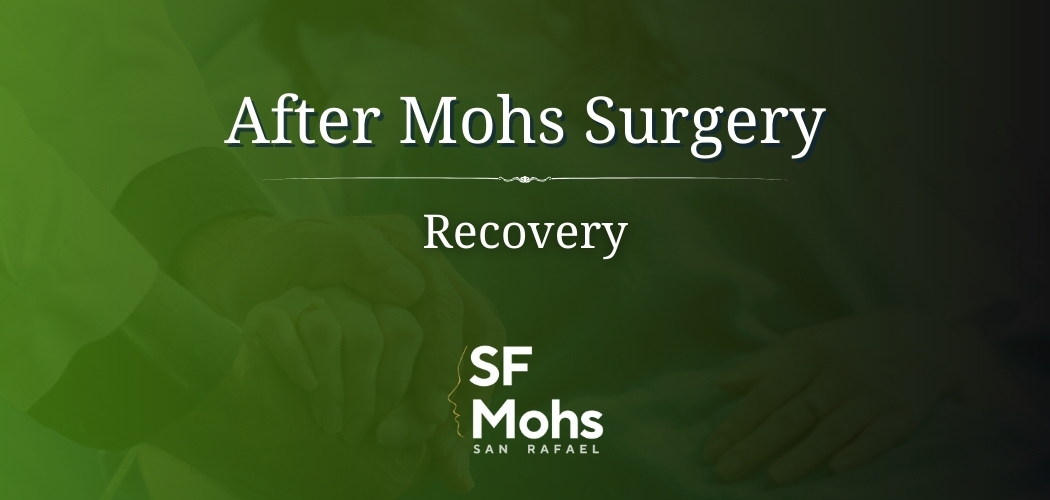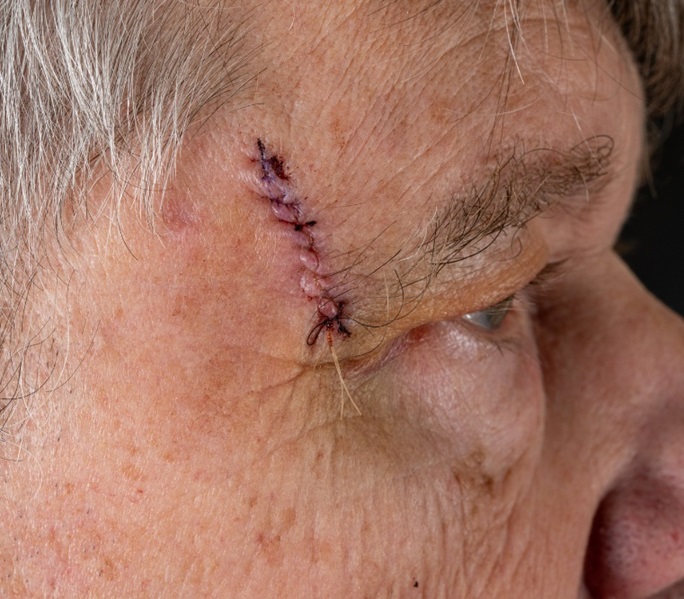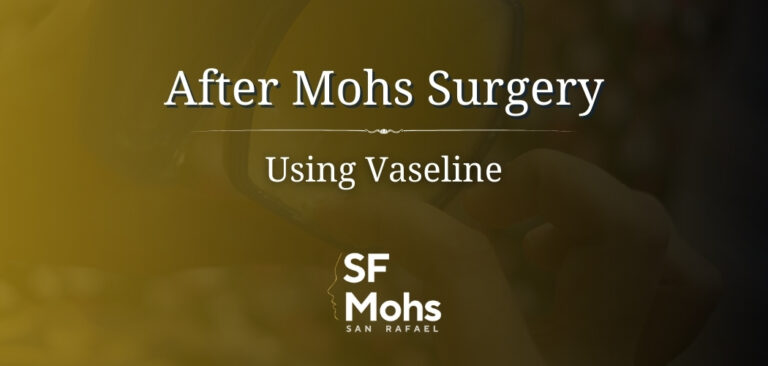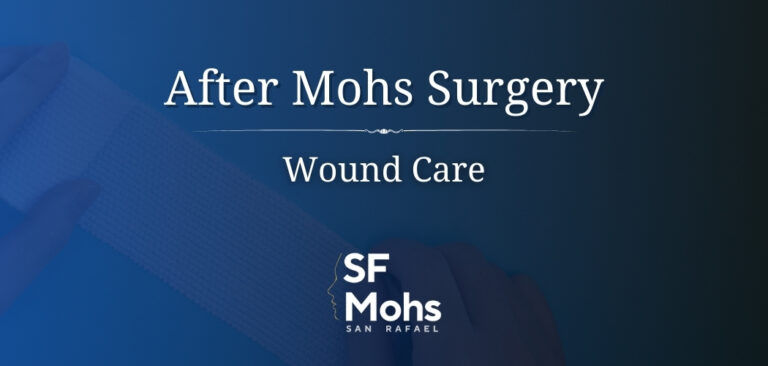
Mohs surgery is a procedure to treat common and rare types of skin cancer. Developed by a general surgeon Frederic E. Mohs in the 1930s, this procedure is quite common.
Every year in the United States, Mohs surgery is performed around 850,000 times. Since Mohs surgery is a precise procedure, it has a success rate of around 99%.
For patients who undergo Mohs surgery on the face, recovery is a major concern. It’s impossible not to wonder what to expect, when you can start wearing makeup, and how long it takes to fully recover.
Learn about recovery from Mohs surgery on the face on this page.
Recovering from Facial Mohs Surgery
Mohs surgery is a minimally invasive procedure, but it still needs time to recover from.
During the initial consultation, your dermatologist will tell you everything you need to know about surgery and recovery, including wound care.
After the procedure, your doctor will take you through every step of the recovery process and explain what to expect and how to make it as smooth as possible.
Book a Consultation With Dr. Ravinder Gogia, MD
San Rafael’s Leading Mohs Surgeon
Dr. Gogia is a board-certified Dermatologist and specialist in Mohs Surgery.
We serve areas including:
We can help if you:
Pain Management
Following the facial Mohs surgery, it’s normal to feel pain or discomfort. Studies confirm that patients often experience pain in the short-term postoperative period while in the long term you might experience:
Since the face is the most pressure-sensitive area of your body, this could explain the presence of pain and other symptoms.
Duration and intensity of pain after facial Mohs surgery depends on several factors. These factors include:
Pain management usually involves over-the-counter pain relief. One study found that about half of Mohs surgery patients take medications for pain control. The severity of pain declined successfully with each day after the procedure. For most patients, ibuprofen (Advil) or acetaminophen (Tylenol) is enough to manage pain.
Evidence supports the use of ibuprofen or acetaminophen for pain management following dermatologic surgery, whereas opioids should only be prescribed in small amounts. Make sure to take medications as directed.
Besides medications, pain management also requires the following measures:

How Long Does Swelling Last After Mohs Surgery on the Face?
How long the swelling lasts varies from one person to another.
It’s common to experience swelling for a few days or weeks after this surgical procedure. The initial swelling tends to peak within 48 hours after the surgery before gradually reducing. For some people, swelling isn’t at its worst until three to four days post-op.
Keep in mind that swelling and bruising are normal. They may improve within a week. Factors that influence how long it takes for swelling to go away include:
How Long Does It Take Mohs Surgery to Heal?
The healing process after Mohs surgery depends on several factors, including:
Due to the above factors, healing may vary from one person to another. However, it may take four to six weeks for a wound to heal completely. On the other hand, scars may continue to heal for 12 to 18 months post-op.

Mohs Surgery Recovery Timeline
The typical recovery experience for patients who undergo Mohs surgery is quite simple and uneventful.
To achieve a smooth recovery, you should adhere to the post-operative care instructions provided by your dermatologist.
It’s important to keep in mind that it takes one to two hours to complete one layer of skin removal during this procedure. Patients generally need to have more than one layer removed. This depends on the depth to which cancer cells have spread. While Mohs surgery is minimally invasive, you’ll still have to pay attention to maximize your recovery.
Below, you can see what to expect at different stages of the recovery process.
Immediate Effects
Immediately after the surgery, the wound is bandaged. It’s normal to experience pain, swelling, bruising, or discomfort after the procedure. As mentioned above, you will be instructed to take over-the-counter pain relief. In most cases, they’re enough to alleviate pain.
You will need to rest and avoid strenuous activities or anything that puts a lot of strain or pressure on the surgical area. Some patients may need a follow-up the next day for suture removal or wound assessment.
After the procedure, your doctor will discuss how the excision went and inform you about the next steps.
Patients should avoid showering for the first 24 hours after the surgery. The surgical area should remain dry during this time.
Short-Term Recovery
Short-term recovery involves the period a few days after the procedure. For an optimal healing process, make sure to follow the postoperative instructions.
During this time, it’s important to keep the surgical site clean and dry. You will need plenty of rest and avoid vigorous activities. Although the wound may start healing, you will still need to put on a bandage to prevent infection. That also implies changing the bandage regularly.
You’ll also be asked to use Vaseline to keep the wound healthy while healing. To lower the risk of infection and manage inflammation, a doctor may prescribe antibiotics. Take them as directed.
Swelling and redness are still present during this time. Don’t panic, it’s normal. With proper care, you can expect them to subside quickly.
Your surgeon will want to monitor the healing process, which is why you should go to the scheduled appointments. Within five to 10 days the sutures for most sites, if used for this procedure, are removed. The removal timeframe may depend on the location. For example, sutures on the scalp are removed within two weeks.
Long-Term Recovery
Recovery from Mohs surgery on the face isn’t extensive or physically gruelling. Patients may be able to return to regular activities within two weeks after the surgery.
Some patients may need additional follow-up care with other specialists such as reconstructive plastic surgeons. Additional care depends on the extent of the procedure.
Of course, your preferences play a role too.
When the wound heals completely, you may have a small scar. At first, these will appear red or raised, but eventually, the scars flatten. You can minimize the appearance of scars by taking care of your wound properly. For example, topical creams and silicone gel sheets can be helpful for scarring.

What to Avoid After Mohs Surgery?
Adherence to the postoperative instructions is crucial for proper recovery after Mohs surgery.
In addition to getting enough rest and taking care of wounds, you will need to avoid certain things. For example, you will need to avoid engaging in activities that strain your wound.
Here are some other activities to avoid:
Sun Exposure
Avoiding sun exposure is crucial for proper healing, minimizing scarring, and lowering the risk of complications. To avoid sun exposure, you should do the following:
In addition to avoiding sun exposure, you should avoid tanning beds too. Tanning beds expose your skin to UV radiation. That means they can jeopardize the healing process too.
Can You Drive After Mohs Surgery?
Since the procedure can cause pain and swelling, you’re probably wondering when you can start driving.
In most cases, patients can drive themselves home after the surgery, if the procedure is relatively minor. For more extensive surgery, it’s better to have someone else drive you home. Also, keep in mind that removal of skin cancer from the face requires bandages, which may interfere with vision.
It’s not uncommon for people to feel tired after the surgery. In these cases, it’s better to let someone else drive. However, it’s usually fine to drive the next day.
When Can I Wear Makeup After Mohs Surgery?
Immediately after Mohs surgery, you should avoid wearing makeup. Your skin needs time to heal, but makeup could introduce bacteria and irritate the sensitive area.
The answer to when you can start wearing makeup depends on the extent of the procedure and the healing process.
Most patients can start wearing makeup in two to three weeks after the procedure. Follow your surgeon’s instructions and start wearing makeup when they say it’s okay to do so.
When a surgeon gives you a green light to wear makeup, you should be mindful of the products you use. Opt for hypoallergenic and non-comedogenic products. Ideally, you should avoid applying makeup on the surgical area until the wound heals completely.
Will Hair Grow Back after Mohs Surgery on the Scalp?
There is no one-size-fits-all rule when it comes to hair growth following Mohs surgery on the scalp. Hair regrowth depends on factors such as the size of the surgical area, the type of closure used, and the depth of the procedure.
The hair will likely not grow back in cases when skin cancer goes deep and the wound isn’t sutured closed. Conversely, your hair will grow back if the wound is sutured closed. Hair may grow back after smaller, less invasive surgeries.
Hair won’t grow back when the procedure requires a skin graft.
Express your concerns to a surgeon during consultations. The healthcare professional explains hair will grow back after Mohs surgery on the scalp and what to expect.
When to Call the Doctor?
After the surgery, patients receive instructions to take care of the wound and what to avoid while recovering. They are advised to call the doctor in case they have concerns. That way, you will receive proper guidance on support. You’re probably wondering how to recognize the signs when to call the doctor. These include:
Conclusion
Mohs surgery is precise and has a high success rate, but to ensure smooth recovery it’s essential to follow postoperative instructions.
Take care of your wound, avoid sun exposure, get some rest, and call a doctor in case you have concerns.


